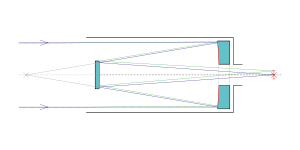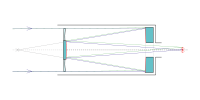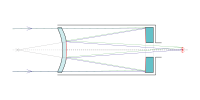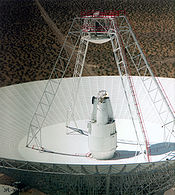
Cassegrain reflector
Encyclopedia
The Cassegrain reflector is a combination of a primary concave mirror and a secondary convex mirror, often used in optical telescope
s and radio antenna
s.
In a symmetrical Cassegrain both mirrors are aligned about the optical axis
, and the primary mirror usually contains a hole in the centre thus permitting the light to reach an eyepiece
, a camera
, or a light detector. Alternatively, as in many radio telescopes, the final focus may be in front of the primary. In an asymmetrical Cassegrain, the mirror(s) may be tilted to avoid obscuration of the primary or the need for a hole in the primary mirror (or both).
The classic Cassegrain configuration uses a parabolic reflector
as the primary while the secondary mirror is hyperbolic. However, variations exist where the primary is hyperbolic for increased performance, and where the primary and/or secondary are spherical or elliptical for ease of manufacturing.
The Cassegrain reflector is named after a published reflecting telescope
design that appeared in the April 25, 1672 Journal des sçavans
which has been attributed to Laurent Cassegrain
. Similar designs using convex secondaries have been found in the Bonaventura Cavalieri
's 1632 writings describing burning mirrors and Marin Mersenne
's 1636 writings describing telescope designs. James Gregory's 1662 attempts to create a reflecting telescope included a Cassegrain configuration, judging by a convex secondary mirror found among his experiments.
The Cassegrain design is also used in catadioptric systems.

It makes use of the special properties of parabolic and hyperbolic reflectors. A concave parabolic reflector
will reflect all incoming light rays parallel to its axis of symmetry to a single point, the focus. A convex hyperbolic reflector has two foci and will reflect all light rays directed at one of its two foci towards its other focus. The mirrors in this type of telescope are designed and positioned so that they share one focus and so that the second focus of the hyperbolic mirror will be at the same point at which the image is to be observed, usually just outside the eyepiece. The parabolic mirror reflects parallel light rays entering the telescope to its focus, which is also the focus of the hyperbolic mirror. The hyperbolic mirror then reflects those light rays to its other focus, where the image is observed.
The radii of curvature
of the primary and secondary mirrors, respectively, in the classic configuration are

and
where
If, instead of and
and  , the known quantities are the focal length of the primary mirror,
, the known quantities are the focal length of the primary mirror,  , and the distance to the focus behind the primary mirror,
, and the distance to the focus behind the primary mirror,  , then
, then  and
and  .
.
The conic constant
of the primary mirror is that of a parabola, , and that of the secondary mirror,
, and that of the secondary mirror,  , is chosen to shift the focus to the desired location:
, is chosen to shift the focus to the desired location:
 ,
,
where ,
,
and is the secondary magnification.
is the secondary magnification.
and spherical aberration at a flat focal plane, making it well suited for wide field and photographic observations. It was invented by George Willis Ritchey
and Henri Chrétien
in the early 1910s.
in 1930 following discussion between amateur astronomer Allan Kirkham and Albert G. Ingalls, the magazine editor at the time. It uses a concave elliptical
primary mirror and a convex spherical
secondary. While this system is easier to grind than a classic Cassegrain or Ritchey–Chretien system, it does not correct for off-axis coma and field curvature so the image degrades quickly off-axis. Because this is less noticeable at longer focal ratio
s, Dall–Kirkhams are seldom faster than f/15.
) which uses tilted mirrors to avoid the secondary mirror casting a shadow on the primary. However, while eliminating diffraction patterns this leads to several other aberrations that must be corrected.
Several different off-axis configurations are used for radio antennas.
Another off-axis, unobstructed design and variant of the cassegrain is the 'YOLO' reflector invented by Arthur Leonard. This design uses a spherical or parabolic primary and a mechanically warped spherical secondary to correct for off-axis induced astigmatism. When set up correctly the yolo can give uncompromising unobstructed views of planetary objects and non-wide field targets, with no lack of contrast or image quality caused by spherical aberration. The lack of obstruction also eliminates the diffraction associated with cassegrain and newtonian reflector astrophotography.
 The Schmidt–Cassegrain was developed from the wide-field Schmidt camera
The Schmidt–Cassegrain was developed from the wide-field Schmidt camera
, although the Cassegrain configuration gives it a much narrower field of view. The first optical element is a Schmidt corrector plate
. The plate is figured
by placing a vacuum on one side, and grinding the exact correction required to correct the spherical aberration
caused by the primary mirror. Schmidt-Cassegrains are popular with amateur astronomers. An early Schmidt–Cassegrain camera was patented in 1946 by artist/architect/physicist Roger Hayward
, with the film holder placed outside the telescope.
 The Maksutov–Cassegrain is a variation of the Maksutov telescope
The Maksutov–Cassegrain is a variation of the Maksutov telescope
named after the Soviet
/Russia
n optician
and astronomer
Dmitri Dmitrievich Maksutov
. It starts with an optically transparent corrector lens that is a section of a hollow sphere. It has a spherical primary mirror, and a spherical secondary that in this application is usually a mirrored section of the corrector lens.
, in which the element acts as a second surface mirror, having a reflective coating applied to the surface facing the sky.
 Cassegrain designs are also utilized in satellite telecommunications earth station
Cassegrain designs are also utilized in satellite telecommunications earth station
antennas and radio telescope
s, ranging in size from 6.3 metres to 70 metres. The centrally located sub-reflector serves to focus radio frequency signals in a similar fashion to optical telescopes.
Optical telescope
An optical telescope is a telescope which is used to gather and focus light mainly from the visible part of the electromagnetic spectrum for directly viewing a magnified image for making a photograph, or collecting data through electronic image sensors....
s and radio antenna
Antenna (radio)
An antenna is an electrical device which converts electric currents into radio waves, and vice versa. It is usually used with a radio transmitter or radio receiver...
s.
In a symmetrical Cassegrain both mirrors are aligned about the optical axis
Optical axis
An optical axis is a line along which there is some degree of rotational symmetry in an optical system such as a camera lens or microscope.The optical axis is an imaginary line that defines the path along which light propagates through the system...
, and the primary mirror usually contains a hole in the centre thus permitting the light to reach an eyepiece
Eyepiece
An eyepiece, or ocular lens, is a type of lens that is attached to a variety of optical devices such as telescopes and microscopes. It is so named because it is usually the lens that is closest to the eye when someone looks through the device. The objective lens or mirror collects light and brings...
, a camera
Camera
A camera is a device that records and stores images. These images may be still photographs or moving images such as videos or movies. The term camera comes from the camera obscura , an early mechanism for projecting images...
, or a light detector. Alternatively, as in many radio telescopes, the final focus may be in front of the primary. In an asymmetrical Cassegrain, the mirror(s) may be tilted to avoid obscuration of the primary or the need for a hole in the primary mirror (or both).
The classic Cassegrain configuration uses a parabolic reflector
Parabolic reflector
A parabolic reflector is a reflective device used to collect or project energy such as light, sound, or radio waves. Its shape is that of a circular paraboloid, that is, the surface generated by a parabola revolving around its axis...
as the primary while the secondary mirror is hyperbolic. However, variations exist where the primary is hyperbolic for increased performance, and where the primary and/or secondary are spherical or elliptical for ease of manufacturing.
The Cassegrain reflector is named after a published reflecting telescope
Reflecting telescope
A reflecting telescope is an optical telescope which uses a single or combination of curved mirrors that reflect light and form an image. The reflecting telescope was invented in the 17th century as an alternative to the refracting telescope which, at that time, was a design that suffered from...
design that appeared in the April 25, 1672 Journal des sçavans
Journal des sçavans
The Journal des sçavans , founded by Denis de Sallo, was the earliest academic journal published in Europe, that from the beginning also carried a proportion of material that would not now be considered scientific, such as obituaries of famous men, church history, and legal reports...
which has been attributed to Laurent Cassegrain
Laurent Cassegrain
Laurent Cassegrain was a Catholic priest who is notable as the probable inventor of the Cassegrain reflector, a folded two mirror reflecting telescope design.-Biography:...
. Similar designs using convex secondaries have been found in the Bonaventura Cavalieri
Bonaventura Cavalieri
Bonaventura Francesco Cavalieri was an Italian mathematician. He is known for his work on the problems of optics and motion, work on the precursors of infinitesimal calculus, and the introduction of logarithms to Italy...
's 1632 writings describing burning mirrors and Marin Mersenne
Marin Mersenne
Marin Mersenne, Marin Mersennus or le Père Mersenne was a French theologian, philosopher, mathematician and music theorist, often referred to as the "father of acoustics"...
's 1636 writings describing telescope designs. James Gregory's 1662 attempts to create a reflecting telescope included a Cassegrain configuration, judging by a convex secondary mirror found among his experiments.
The Cassegrain design is also used in catadioptric systems.
Cassegrain designs

The "Classic" Cassegrain
The "Classic" Cassegrain has a parabolic primary mirror, and a hyperbolic secondary mirror that reflects the light back down through a hole in the primary. Folding the optics makes this a compact design. On smaller telescopes, and camera lenses, the secondary is often mounted on an optically flat, optically clear glass plate that closes the telescope tube. This support eliminates the "star-shaped" diffraction effects caused by a straight-vaned support spider. The closed tube stays clean, and the primary is protected, at the cost of some loss of light-gathering power.It makes use of the special properties of parabolic and hyperbolic reflectors. A concave parabolic reflector
Parabolic reflector
A parabolic reflector is a reflective device used to collect or project energy such as light, sound, or radio waves. Its shape is that of a circular paraboloid, that is, the surface generated by a parabola revolving around its axis...
will reflect all incoming light rays parallel to its axis of symmetry to a single point, the focus. A convex hyperbolic reflector has two foci and will reflect all light rays directed at one of its two foci towards its other focus. The mirrors in this type of telescope are designed and positioned so that they share one focus and so that the second focus of the hyperbolic mirror will be at the same point at which the image is to be observed, usually just outside the eyepiece. The parabolic mirror reflects parallel light rays entering the telescope to its focus, which is also the focus of the hyperbolic mirror. The hyperbolic mirror then reflects those light rays to its other focus, where the image is observed.
The radii of curvature
Radius of curvature (optics)
Radius of curvature has specific meaning and sign convention in optical design. A spherical lens or mirror surface has a center of curvature located in either along or decentered from the system local optical axis. The vertex of the lens surface is located on the local optical axis...
of the primary and secondary mirrors, respectively, in the classic configuration are

and

where
-
 is the effective focal lengthFocal lengthThe focal length of an optical system is a measure of how strongly the system converges or diverges light. For an optical system in air, it is the distance over which initially collimated rays are brought to a focus...
is the effective focal lengthFocal lengthThe focal length of an optical system is a measure of how strongly the system converges or diverges light. For an optical system in air, it is the distance over which initially collimated rays are brought to a focus...
of the system, -
 is the back focal length (the distance from the secondary to the focus), and
is the back focal length (the distance from the secondary to the focus), and -
 is the distance between the two mirrors.
is the distance between the two mirrors.
If, instead of
 and
and  , the known quantities are the focal length of the primary mirror,
, the known quantities are the focal length of the primary mirror,  , and the distance to the focus behind the primary mirror,
, and the distance to the focus behind the primary mirror,  , then
, then  and
and  .
.The conic constant
Conic constant
In geometry, the conic constant is a quantity describing conic sections, and is represented by the letter K...
of the primary mirror is that of a parabola,
 , and that of the secondary mirror,
, and that of the secondary mirror,  , is chosen to shift the focus to the desired location:
, is chosen to shift the focus to the desired location: ,
,where
 ,
,and
 is the secondary magnification.
is the secondary magnification.Ritchey–Chrétien
The Ritchey–Chrétien is a specialized Cassegrain reflector which has two hyperbolic mirrors (instead of a parabolic primary). It is free of comaComa (optics)
In optics , the coma in an optical system refers to aberration inherent to certain optical designs or due to imperfection in the lens or other components which results in off-axis point sources such as stars appearing distorted, appearing to have a tail like a comet...
and spherical aberration at a flat focal plane, making it well suited for wide field and photographic observations. It was invented by George Willis Ritchey
George Willis Ritchey
George Willis Ritchey was an American optician and telescope maker and astronomer born at Tuppers Plains, Ohio....
and Henri Chrétien
Henri Chrétien
Henri Jacques Chrétien was a French astronomer and an inventor.Born in Paris, France, his most famous invention is the anamorphic widescreen process, that resulted in the CinemaScope, and the co-invention of the Ritchey-Chrétien telescope , which was anadvanced type of astronomical telescope, now...
in the early 1910s.
Dall–Kirkham
The Dall–Kirkham Cassegrain telescope's design was created by Horace Dall in 1928 and took on the name in an article published in Scientific AmericanScientific American
Scientific American is a popular science magazine. It is notable for its long history of presenting science monthly to an educated but not necessarily scientific public, through its careful attention to the clarity of its text as well as the quality of its specially commissioned color graphics...
in 1930 following discussion between amateur astronomer Allan Kirkham and Albert G. Ingalls, the magazine editor at the time. It uses a concave elliptical
Ellipse
In geometry, an ellipse is a plane curve that results from the intersection of a cone by a plane in a way that produces a closed curve. Circles are special cases of ellipses, obtained when the cutting plane is orthogonal to the cone's axis...
primary mirror and a convex spherical
Sphere
A sphere is a perfectly round geometrical object in three-dimensional space, such as the shape of a round ball. Like a circle in two dimensions, a perfect sphere is completely symmetrical around its center, with all points on the surface lying the same distance r from the center point...
secondary. While this system is easier to grind than a classic Cassegrain or Ritchey–Chretien system, it does not correct for off-axis coma and field curvature so the image degrades quickly off-axis. Because this is less noticeable at longer focal ratio
F-number
In optics, the f-number of an optical system expresses the diameter of the entrance pupil in terms of the focal length of the lens; in simpler terms, the f-number is the focal length divided by the "effective" aperture diameter...
s, Dall–Kirkhams are seldom faster than f/15.
Off-axis configurations
An unusual variant of the Cassegrain is the Schiefspiegler telescope ("skewed" or "oblique reflector", also known as "kutter telescope" after its inventor Anton KutterAnton Kutter
Anton Kutter was a German film director and screenwriter. He studied mechanical engineering at Stuttgart Technical University....
) which uses tilted mirrors to avoid the secondary mirror casting a shadow on the primary. However, while eliminating diffraction patterns this leads to several other aberrations that must be corrected.
Several different off-axis configurations are used for radio antennas.
Another off-axis, unobstructed design and variant of the cassegrain is the 'YOLO' reflector invented by Arthur Leonard. This design uses a spherical or parabolic primary and a mechanically warped spherical secondary to correct for off-axis induced astigmatism. When set up correctly the yolo can give uncompromising unobstructed views of planetary objects and non-wide field targets, with no lack of contrast or image quality caused by spherical aberration. The lack of obstruction also eliminates the diffraction associated with cassegrain and newtonian reflector astrophotography.
Schmidt–Cassegrain

Schmidt camera
A Schmidt camera, also referred to as the Schmidt telescope, is a catadioptric astrophotographic telescope designed to provide wide fields of view with limited aberrations. Other similar designs are the Wright Camera and Lurie-Houghton telescope....
, although the Cassegrain configuration gives it a much narrower field of view. The first optical element is a Schmidt corrector plate
Schmidt corrector plate
A Schmidt corrector plate is an aspheric lens which is designed to correct the spherical aberration in the spherical primary mirror it is combined with. It was invented by Bernhard Schmidt in 1931, although it may have been independently invented by Finnish astronomer Yrjö Väisälä in 1924...
. The plate is figured
Figuring
Figuring is the process of final polishing of an optical surface to remove imperfections or modify the surface curvature to achieve the shape required for a given application.-Types of figuring:...
by placing a vacuum on one side, and grinding the exact correction required to correct the spherical aberration
Spherical aberration
thumb|right|Spherical aberration. A perfect lens focuses all incoming rays to a point on the [[Optical axis|optic axis]]. A real lens with spherical surfaces suffers from spherical aberration: it focuses rays more tightly if they enter it far from the optic axis than if they enter closer to the...
caused by the primary mirror. Schmidt-Cassegrains are popular with amateur astronomers. An early Schmidt–Cassegrain camera was patented in 1946 by artist/architect/physicist Roger Hayward
Roger Hayward
Roger Hayward was an American artist, architect, optical designer and astronomer. He is the inventor of an early Schmidt-Cassegrain camera that was patented in 1945. He was born on January 7, 1899 to mother, artist Ina Kittredge Hayward and local businessman and time piece hobbyist Robert Peter...
, with the film holder placed outside the telescope.
Maksutov–Cassegrain

Maksutov telescope
The Maksutov is a catadioptric telescope design that combines a spherical mirror with a weakly negative meniscus lens in a design that takes advantage of all the surfaces being nearly "spherically symmetrical". The negative lens is usually full diameter and placed at the entrance pupil of the...
named after the Soviet
Soviet Union
The Soviet Union , officially the Union of Soviet Socialist Republics , was a constitutionally socialist state that existed in Eurasia between 1922 and 1991....
/Russia
Russia
Russia or , officially known as both Russia and the Russian Federation , is a country in northern Eurasia. It is a federal semi-presidential republic, comprising 83 federal subjects...
n optician
Scientific Equipment Optician
A Scientific equipment optician is an individual who makes and adjusts other optical aids, including telescope optics and microscope lenses. See also Optician for individuals who make and adjust eyeglasses.-Telescope opticians:* James Gilbert Baker* John A...
and astronomer
Astronomer
An astronomer is a scientist who studies celestial bodies such as planets, stars and galaxies.Historically, astronomy was more concerned with the classification and description of phenomena in the sky, while astrophysics attempted to explain these phenomena and the differences between them using...
Dmitri Dmitrievich Maksutov
Dmitri Dmitrievich Maksutov
Dmitry Dmitrievich Maksutov was a Russian / Soviet optical engineer and amateur astronomer. He is best known as the inventor of the Maksutov telescope.-Biography:...
. It starts with an optically transparent corrector lens that is a section of a hollow sphere. It has a spherical primary mirror, and a spherical secondary that in this application is usually a mirrored section of the corrector lens.
Argunov–Cassegrain
In the Argunov–Cassegrain telescope all optics are spherical, and the classical Cassegrain secondary mirror is replaced by a sub-aperture corrector consisting of three air spaced lens elements. The element farthest from the primary mirror is a Mangin mirrorMangin mirror
In optics, a Mangin mirror is a negative meniscus lens with the reflective surface on the rear side of the glass forming a curved mirror that reflects light without spherical aberration...
, in which the element acts as a second surface mirror, having a reflective coating applied to the surface facing the sky.
Klevtsov–Cassegrain
The Klevtsov–Cassegrain, like the Argunov–Cassegrain, uses a sub-aperture corrector. It consisting of a small meniscus lens and Mangin mirror as its "secondary mirror".Cassegrain radio antennas

Earth station
A ground station, earth station, or earth terminal is a terrestrial terminal station designed for extraplanetary telecommunication with spacecraft, and/or reception of radio waves from an astronomical radio source. Ground stations are located either on the surface of the Earth, or within Earth's...
antennas and radio telescope
Radio telescope
A radio telescope is a form of directional radio antenna used in radio astronomy. The same types of antennas are also used in tracking and collecting data from satellites and space probes...
s, ranging in size from 6.3 metres to 70 metres. The centrally located sub-reflector serves to focus radio frequency signals in a similar fashion to optical telescopes.
See also
- Refracting telescopeRefracting telescopeA refracting or refractor telescope is a type of optical telescope that uses a lens as its objective to form an image . The refracting telescope design was originally used in spy glasses and astronomical telescopes but is also used for long focus camera lenses...
- Catadioptric system
- CelestronCelestronCelestron is a company that manufactures and imports telescopes, binoculars, spotting scopes, microscopes, and accessories for their products.-Origins and History:...
(Schmidt–Cassegrains, Maksutov Cassegrains) - List of telescope types
- Meade Instruments (Schmidt–Cassegrains, Maksutov Cassegrains)
- QuestarQuestar TelescopeQuestar Corporation is a company based in New Hope, Pennsylvania, which manufactures precision optical devices for consumer, industrial, aerospace, and military markets...
(Maksutov Cassegrains) - VixenVixen (telescopes)Vixen is a Japanese company that makes telescopes, binoculars, spotting scopes and accessories for their products.Among many other more mainstream products they have created two unusual varieties of catadioptric telescopes with an open tube design instead of the full-aperture corrector plate of the...
(Cassegrains, Klevtsov–Cassegrain)

